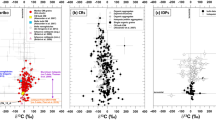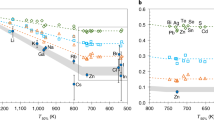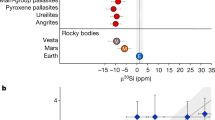Abstract
Determinations of uranium and thorium in carbonaceous chondrites by neutron activation show that both uranium and thorium are inhomogeneously distributed within Type I and are generally homogeneously distributed within Type II carbonaceous chondrites. If Type I carbonaceous chondrites represent primitive solar material, then for the experimentally determined values of the ratio 232Th/238U either a continuous or sudden model of nucleosynthesis is plausible. The value of this ratio does, however, raise some problems.
This is a preview of subscription content, access via your institution
Access options
Subscribe to this journal
Receive 51 print issues and online access
$199.00 per year
only $3.90 per issue
Buy this article
- Purchase on Springer Link
- Instant access to full article PDF
Prices may be subject to local taxes which are calculated during checkout
Similar content being viewed by others
References
Hamaguchi, H., Reed, G. W., and Turkevich, A., Geochim. Cosmochim. Acta, 12, 337 (1957).
Bate, G. L., Huizenga, J. R., and Potratz, H. A., Geochim. Cosmochim. Acta, 16, 88 (1959).
Reed, G. W., Kigoshi, K., and Turkevich, A., Geochim. Cosmochim. Acta, 20, 122 (1960).
Goles, G. G., and Anders, E., Geochim. Cosmochim. Acta, 26, 723 (1962).
Lovering, J. F., and Morgan, J. W., J. Geophys. Res., 69, 1979 (1964).
Urey, H. C., Rev. Geophys., 2, 1 (1964).
Ringwood, A. E., Rev. Geophys., 4, 113 (1966).
Hoyle, F., and Fowler, W. A. in Isotopic and Cosmic Chemistry (edit. by Craig, H., Miller, S., and Wasserburg, G. J.) (North-Holland Publishing Co., Amsterdam, 1963).
Clayton, D. D., J. Geophys. Res., 68, 3715 (1963).
Fowler, W. A., and Hoyle, F., Ann. Phys., 10, 280 (1960).
Morgan, J. W., thesis, Austral. National Univ., Canberra.
Morgan, J. W., and Lovering, J. F., Anal. Chim. Acta., 28, 405 (1963).
Greenland, L. P., and Lovering, J. F., Geochim. Cosmochim. Acta, 29, 821(1965).
Burbidge, E. M., Burbidge, G. R., Fowler, W. A., and Hoyle, F., Rev. Modern Phys., 29, 547 (1957).
Marshall, R. R., Geochim. Cosmochim. Acta, 12, 225 (1957).
Murthy, V. R., and Patterson, C. C., J. Geophys. Res., 67, 1161 (1962).
Helliwell, T. M., Astrophys. J., 133, 566 (1961).
Mutschlecner, P., thesis, Univ. Michigan (1962).
Marshall, R. R., J. Geophys. Res., 67, 2005 (1962).
Author information
Authors and Affiliations
Rights and permissions
About this article
Cite this article
MORGAN, J., LOVERING, J. Uranium and Thorium Abundances in Carbonaceous Chondrites. Nature 213, 873–875 (1967). https://doi.org/10.1038/213873a0
Received:
Published:
Issue Date:
DOI: https://doi.org/10.1038/213873a0
This article is cited by
-
Model ages
Nature (1976)
-
Implied Superheavy Element Decay Lifetime from Meteorites
Nature (1971)
Comments
By submitting a comment you agree to abide by our Terms and Community Guidelines. If you find something abusive or that does not comply with our terms or guidelines please flag it as inappropriate.



